Southwestern plants, French style & tropical verve in the garden of Curt Arnette
Landscape architect Curt Arnette, of Sitio Design, is one of the best and yet most modest garden makers you’ll meet in Austin. Back when I was a newbie gardener, breaking ground at our first house in Austin, he and his wife Melisa were our across-the-street neighbors. What a stroke of luck for me! Over the years, Curt and I each turned our blank-slate front yards of St. Augustine grass into gardens—his a beautiful, New Orleans-style, low-walled courtyard lush with palms under a majestic live oak. Mine was, well, much less impressive, my first baby-gardener experiment, but I learned a lot from Curt, especially about the importance of foliage, structure, and pruning, before we each moved with our families to new (old) homes with new blank-slate yards.
In the years since, I’ve seen a couple of his professionally designed gardens on tours and at Lou Neff Point along the Hike and Bike Trail at Lady Bird Lake. Occasionally I’m asked by garden-tour planners if I can recommend any gardens that haven’t been seen on tour, and I always suggest Curt’s personal garden, which he’s been making for about 10 years on a quiet cul-de-sac in the Circle C neighborhood in southwest Austin. But Curt demurs with a laugh, protesting that it’s not tour-ready and doesn’t yet match the vision in his head.
Sadly for Curt, reticence is lost on me, and I have a (likely annoying) habit of popping by his garden unannounced to see what’s new. Last time I brought a group of garden bloggers with me, my companions on the recent Gardens on Tour; we just happened to be in the neighborhood, so naturally I suggested we do a drive-by of “this great garden I know about.” Poor Curt! We ambushed him while he was out working in the garden—really working, trimming and pulling out plants—not just puttering with a glass of iced tea in hand. After recovering from his surprise at the impromptu tour, Curt graciously invited us and all our snapping cameras into his garden, asking only that we explore the front of his corner-lot garden, not the back, where he had another project going on.
Allow me to be your tour guide! Curt’s garden never fails to wow me right at the curb. On a street of mostly traditional lawns and foundation shrubs, his garden stands out immediately. The public space along the curb is dry and mostly sunny; agave, sotol, yucca, and dasylirion flourish here, their spiky, architectural forms softened by silvery mounds of ‘Powis Castle’ artemisia, purple-blooming salvia, and blond, billowing Mexican feathergrass.
A wider view from the street, near the driveway. In contrast with the public face of the garden, a shade-dappled private garden is hidden behind a low boxwood hedge backed by taller evergreen shrubs, whose entrance is marked by a free-standing blue iron gate, with one side enticingly left open.
Curt found the gate, French-made in the 1800s, at Dreyfus Antiques years ago and used it in the courtyard garden at his first house before bringing it along to his new home and garden. Curt told me that his neighborhood’s HOA restrictions did not allow him to build the low courtyard wall he wanted, so instead he used a clipped hedge of ‘Wintergreen’ boxwood to create a feeling of enclosure and privacy.
Before we step through the gate, let’s explore the outer garden first. An emerald ‘Green Goblet’ agave (Agave salmiana var. ferox ‘Green Goblet’) marks one side of the entry walk. Ooh, I really need to find room for one of these in my garden.
Panning to the right, we see a tapestry of foliage in front of that boxwood hedge.
One of my favorite agaves, ‘Sharkskin’—and it’s a biggie—is softened behind by a fringe of heartleaf skullcap (Scutellaria ovata), which peeks out at the feet of the boxwood hedge.
Toothless sotol (Dasylirion longissimum) creates an airy scrim of thin leaves.
And look at this gorgeous, blue artichoke agave (Agave parryi var. truncata) paired with Gregg’s mistflower and rock penstemon.
A blue-green ‘Whale’s Tongue’ agave (A. ovatifolia) is softened with a feathery clump of snake herb (Dyschoriste linearis), a native groundcover I’m going to try in my garden this fall.
Wheeler sotol (Dasylirion wheeleri)
Yucca australis (syn. Yucca filifera) and Yucca rostrata
Moving around the corner, this is the view from the busier street that runs alongside the house and garden: an effective and tactile screen of foliage in greens, silver, and blue-green.
Entering the private courtyard through the iron gate…
…you step into an open, gravel-floored room, with a bistro table and chairs for relaxing in the shade of the live oaks. Renee, Daphne, and David were busy framing photos too.
Variegated flax lily (Dianella tasmanica ‘Variegata’), clusters at the foot of a tree, brightening a shady corner.
As do the frosted, spiky fronds of silver saw palmetto (Serenoa repens).
Steel edging set into the ground, with only the top line visible (at bottom right), defines the straight-lined planting beds—although a single, feather-shaped Dioon edule breaks out and takes root in the gravel patio.
Curt and Melisa detected a French influence in the architecture of their suburban brick home, so Curt added a bit of French flavor to the courtyard design as well, with Old World-style shutters, soft green paint, a handsome bench set into a boxwood parterre, an iron arbor over the garage, and climbing vines over the doorways. Evergreen fig ivy outlines the front entry, while a ‘Mermaid’ rose clambers above the garage doors.
Now we’re heading around the side of the house. Whereas steel defines the courtyard patio, limestone blocks define the planting beds outside the hedge and separate them from a small area of lawn in the side garden.
Curt doesn’t overlook even the smallest planting opportunity, like placing groundcovers along the base of the boxwood hedges. This is blue shade ruellia (Ruellia squarrosa), a variety I’d never heard of before.
Ice plant offers blue succulent foliage and colorful flowers on this gravelly, one-step retaining wall.
Here’s a vibrant, sun-loving combo that inspired my own recent purchases: ‘Tropicanna’ canna and firecracker fern (Russelia equisetiformis).
Curt uses beach vitex (Vitex rotundifolia) as a shrubby screen between the street and his side garden, along with bamboo muhly (Muhlenbergia dumosa) and spineless prickly pear (Opuntia), not pictured.
Peeking over the low wrought-iron fence that encloses Curt’s back garden, you see a more tropical-looking garden, with a gravel patio surrounded by an exuberance of palm foliage.
A mass of strappy Manfreda maculosa blooms beneath a tall windmill palm, as silver ponyfoot (Dichondra argentea) foams over limestone steps.
Curt constructed a concrete-edged, circular pond just inside the fence, with an offset rill-like fountain pouring into it.
Simply beautiful
I noticed a false red yucca (Beschorneria yuccoides), with rounded seedpods dangling from a recent bloom spike, in the shade of a Japanese maple alongside his house, and mentioned that I’d just bought one at Peckerwood Garden‘s recent plant sale. It dawned on me later that Curt’s garden reminded me of Peckerwood in its mingling of southwestern desert plants, tropical-looking palms, and a variety of shrubs, and in its reliance on foliage texture and form over flowers. I emailed Curt to ask whether he’d been influenced by Peckerwood. He replied that John Fairey, Peckerwood’s owner, was one of his design professors at Texas A&M, and that Fairey’s garden did indeed have a big influence on him.
When asked about his other gardening influences, Curt replied, “I like Big Bend and the variety of plants out there. I like the work of Steve Martino, Roberto Burle Marx, and Raymond Jungles. I also like minimalist, contemporary gardens. I like a lot of different styles but don’t care much for overly formal gardens or gardens that rely too much on flower color. I prefer more leaf color and texture.”
Curt’s own garden illustrates the beauty and year-round interest of a garden created from a mix of striking foliage plants combined with plenty of filler groundcovers and mid-size shrubs. Those of us gardening in the dry shade of live oaks should especially take note. And anyone contending with restrictive HOAs can also learn from Curt’s example of how to substitute creatively—in this case, a hedge for a wall—and still fulfill your garden dreams. Thank you, Curt, for the tour and for your continual inspiration!
All material © 2006-2012 by Pam Penick for Digging. Unauthorized reproduction prohibited.


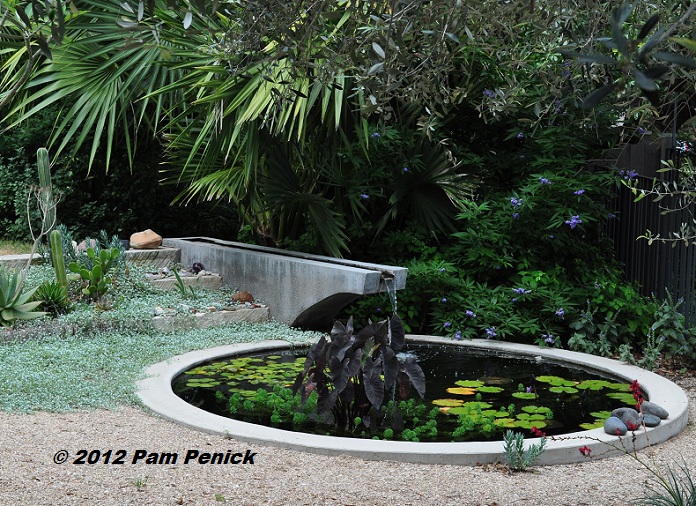
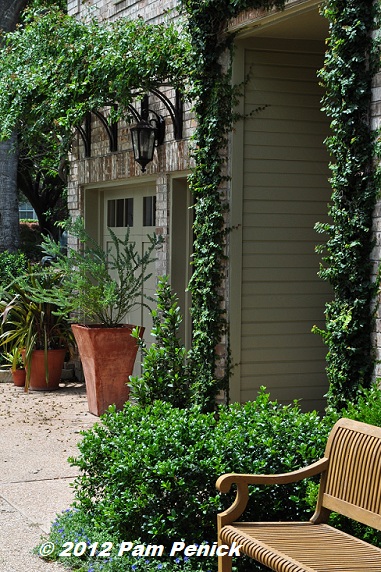
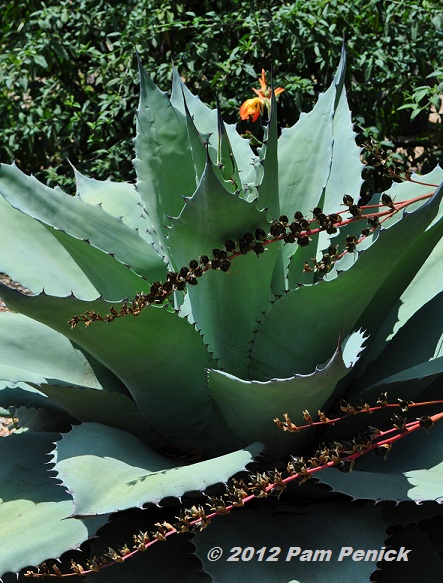
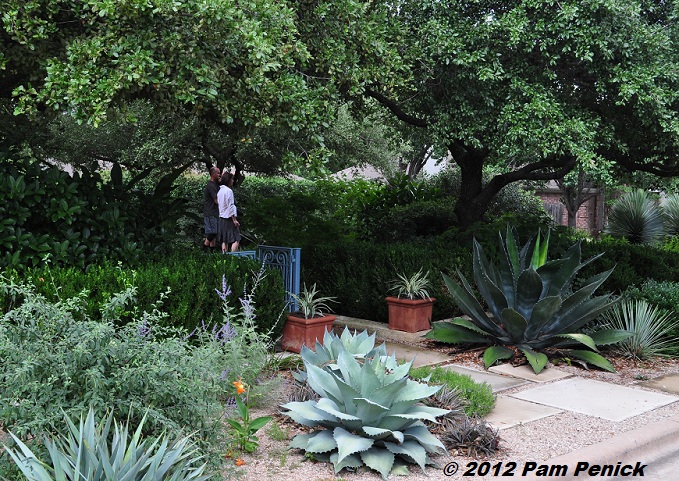
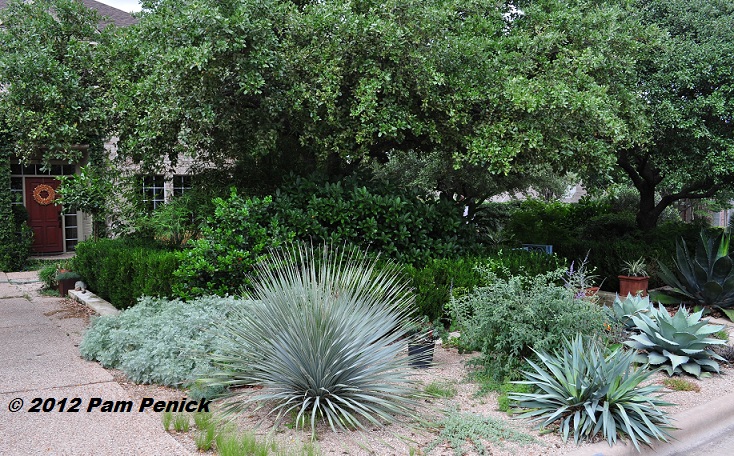
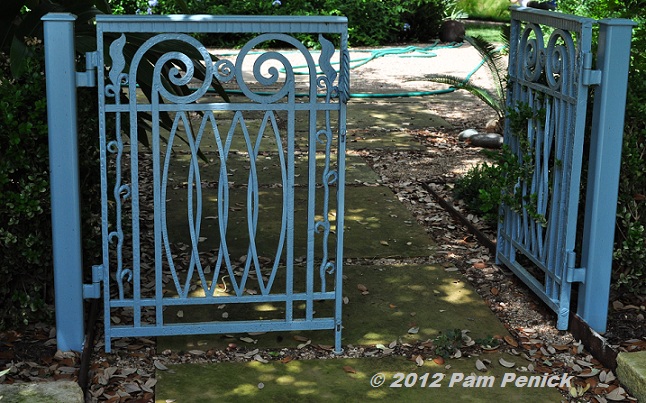
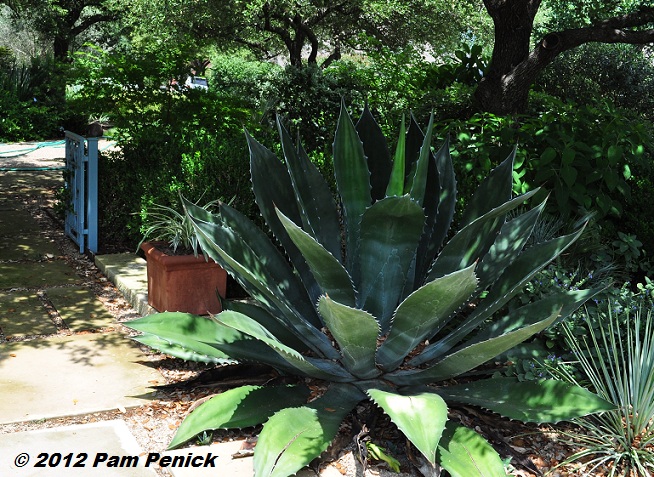
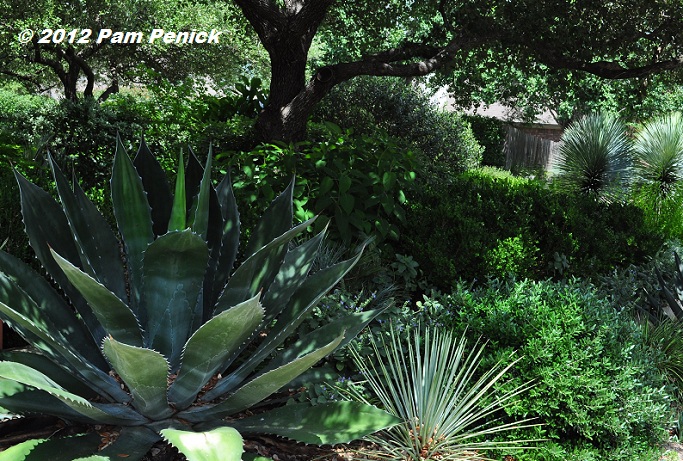
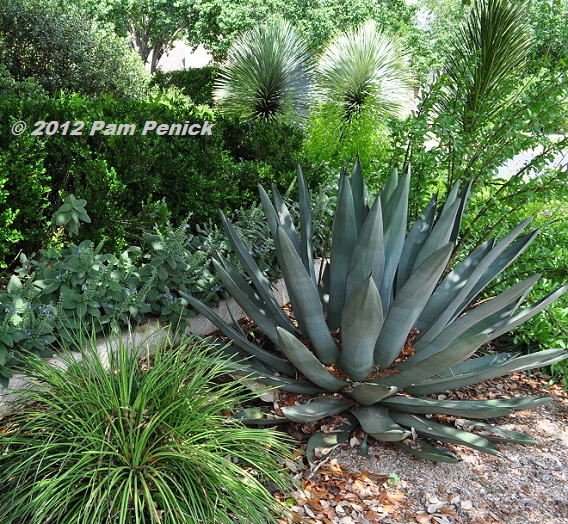
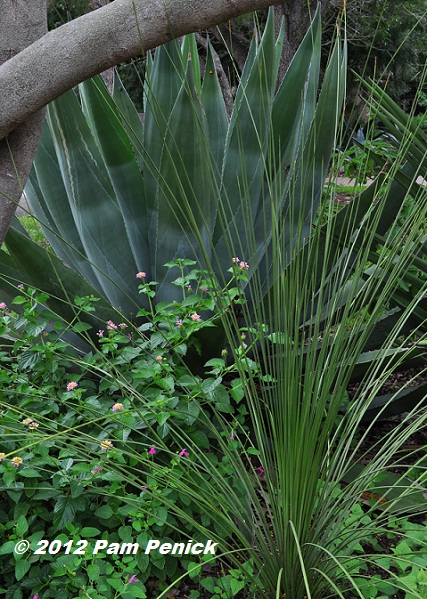
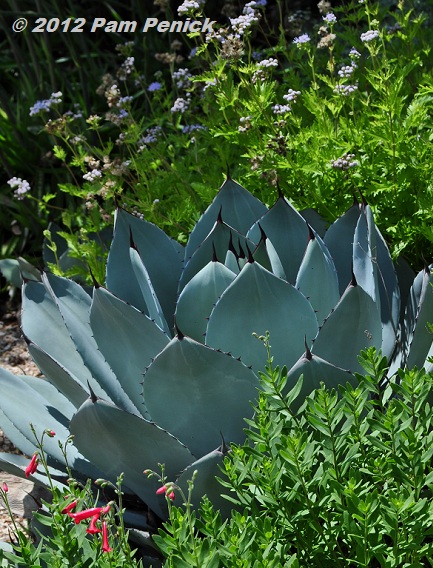
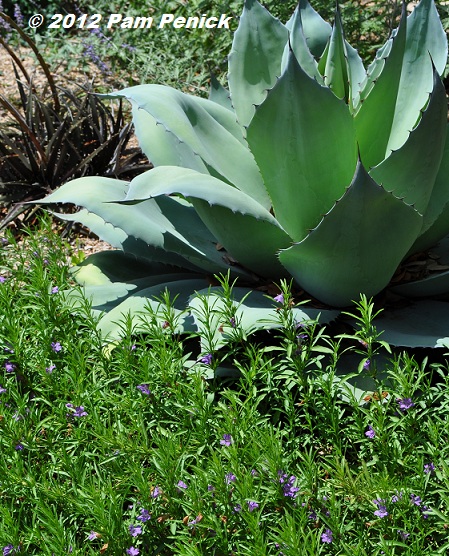
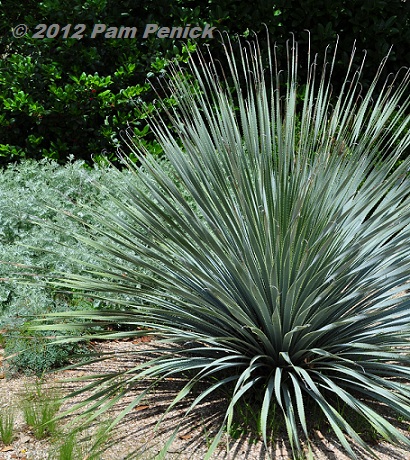
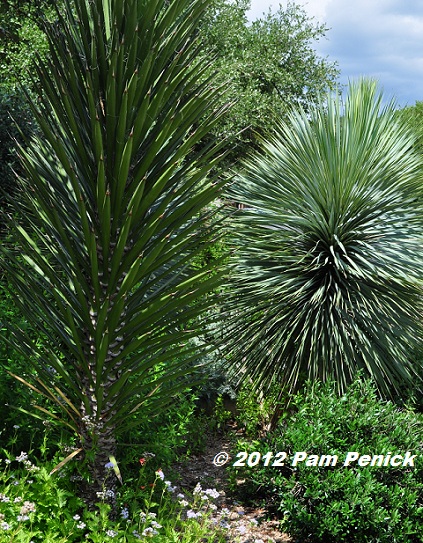
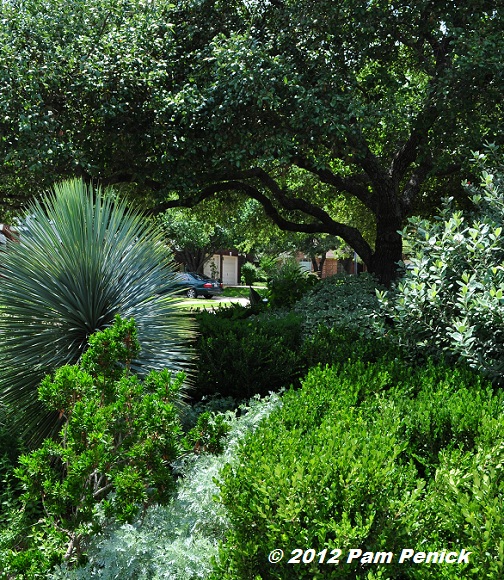
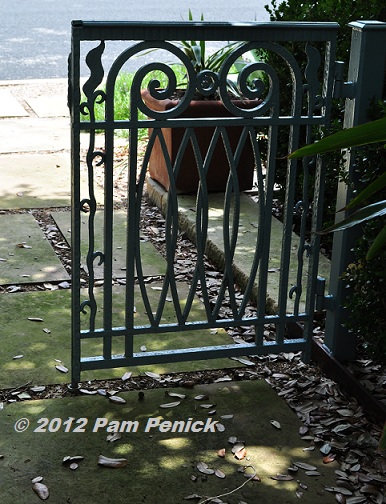
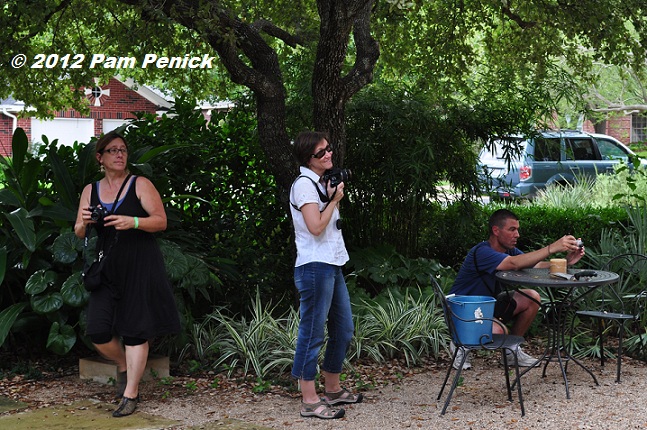
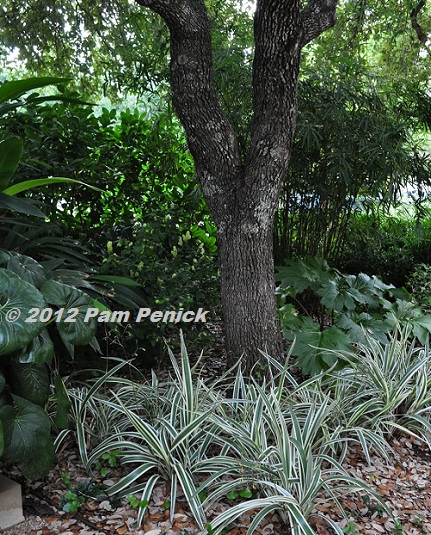
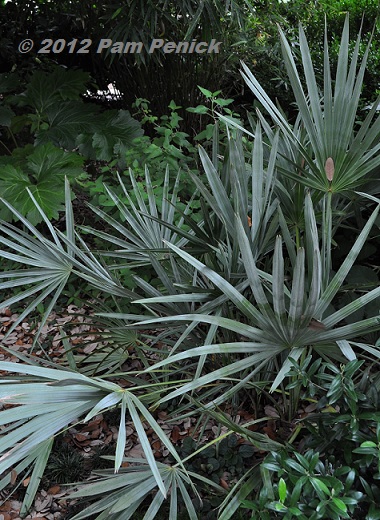
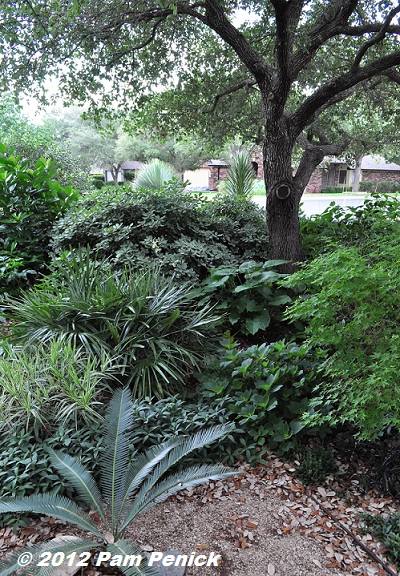
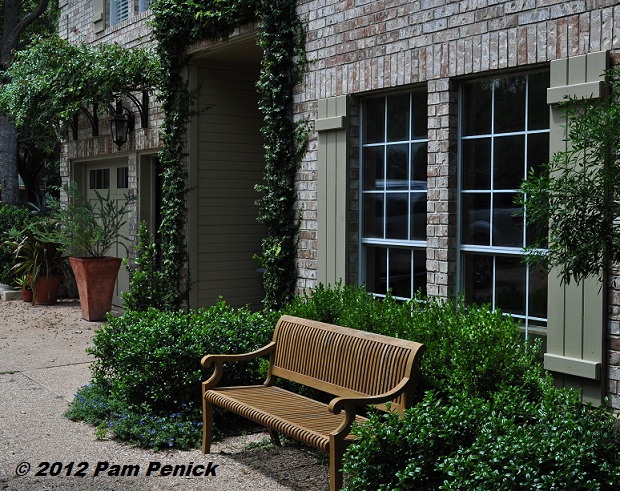
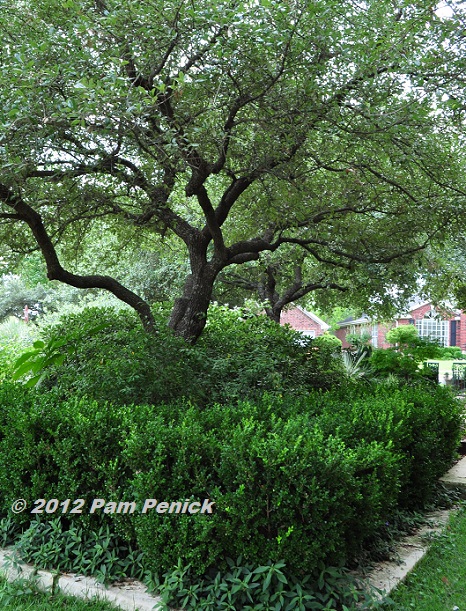
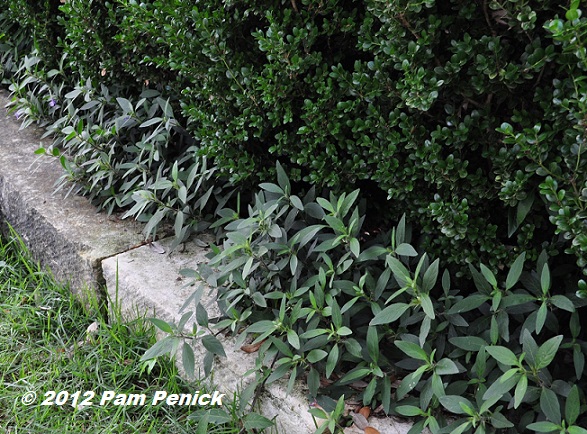
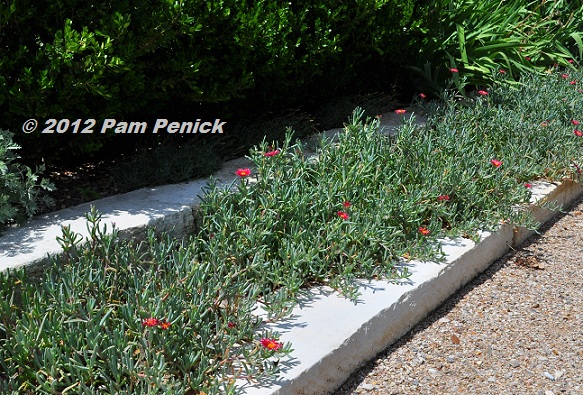
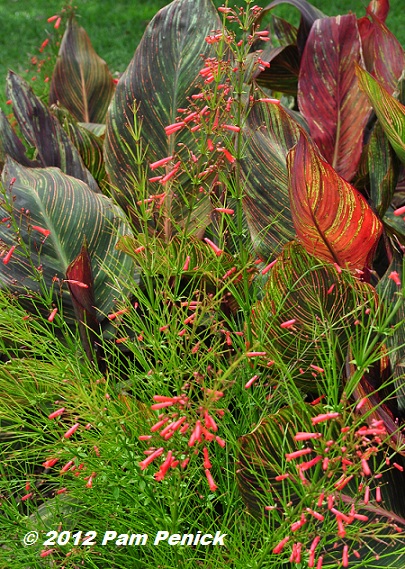
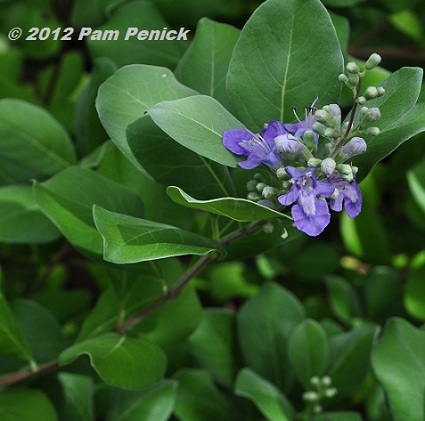
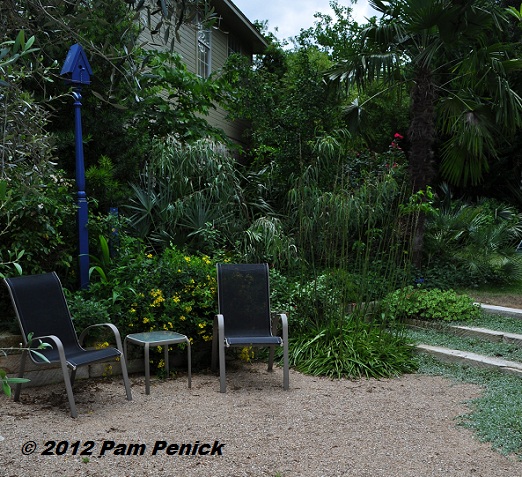
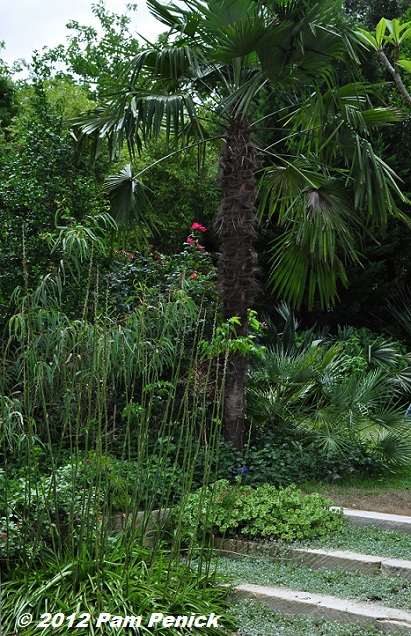
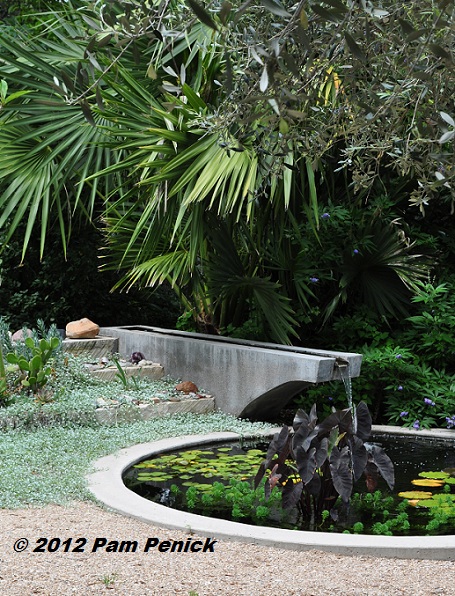
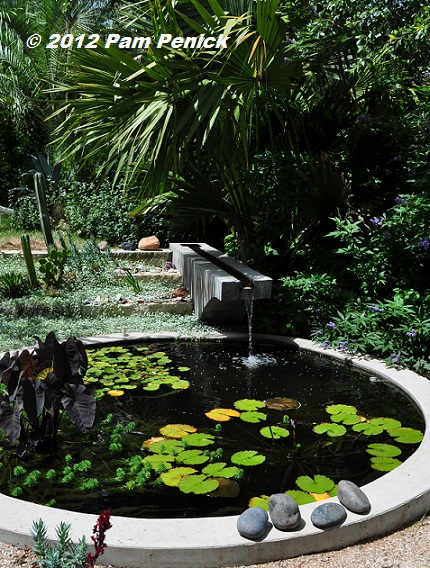
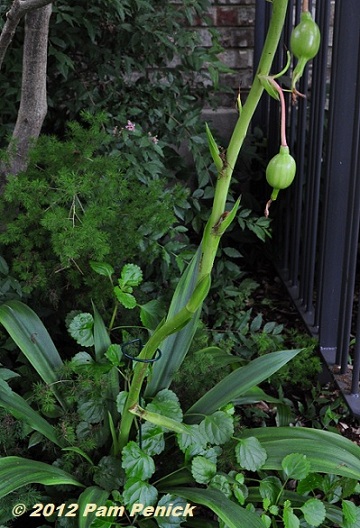
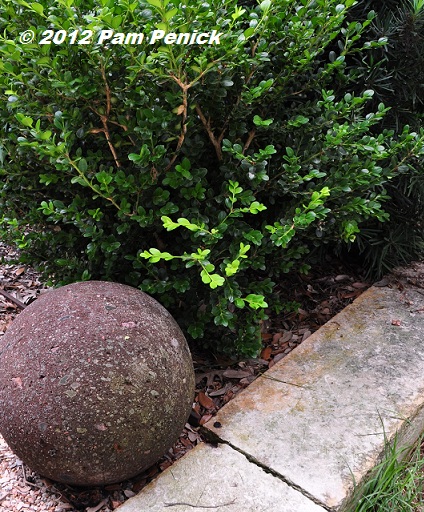
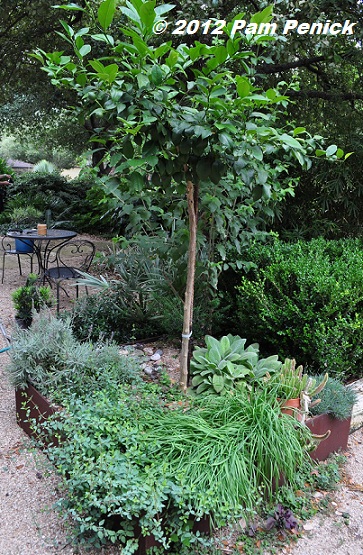
Great way you captured it all, including things I missed…as usual! Thanks so much for posting that memorable day, including Daphne and her goofy camera poses…that may require its own post, not that I would do that or anything. The gardens’ plant layering, classic features, and focal points with soft-sharp…uber-garden tour-worthy. But I especially admire how he experiments with so much, yet weaves it into a coherent design. Very, very impressive.
Yes, I think every designer does some degree of experimentation with plants in his/her garden, and Curt is trying out some unique ones for our area. —Pam
I really do need to look at gardens through your eyes. I missed so much on this wonderful opportunity to see Curt’s own garden. I’m sorry I will miss the garden he designed which is on the GC tour this year.
I’m sorry that you’ll miss that tour too, Jenny. It’s always one of my favorites. That’s the Open Days Austin tour on November 3, if anyone else reading this is interested. —Pam
Wow…what a beautiful space. How lucky you were to live close to this fellow and learn from him, and then follow him to his new garden rather than losing touch. I could stare at the steps/rill/pond all day long…
I was very lucky, Loree. Curt was a great mentor, whether he knew it or not. —Pam
Glorious indeed! Quite the jewel in CC. Wonderful virtual tour, as always!
I’m glad you enjoyed it, MamaHolt. Thinking of you in your cool summer retreat. —Pam
Wow, wow, wow. Lucky indeed to have had him as a neighbor. I’ve wished my whole life for a neighbor that even had an interest in gardening let alone anyone in his league. Never has that happened so I flounder along. I’m not sure why he doesn’t think his garden is tour ready ~ it looks incredible to me. Thanks for sharing the inspiration.
A gardening neighbor is indeed a treasure. I’ve been lucky to have quite a few along the way in my homeownership years. —Pam
What a great mentor…and now it’s your turn.
I suppose you’re right, Ricki, and I do try to mentor in whatever way I can. But one never stops learning either, and I’d love to learn even more from Curt. Hmm, I wonder if he could be talked into teaching a design class… —Pam
Holy cow, I love it! I am totally taking notes.
There’s a lot of inspiration in his garden, isn’t there? —Pam
Great tour of a garden maker who really knows what he’s after and how to get there. Thanks, Pam.
My pleasure, Denise! —Pam
I agree with Kathleen…his garden looks very ready for a tour. I’m thinking, it’s the GARDENER who’s not ready.
This is a lovely garden. How lucky to have had him as a neighbor.
Going back to stare at these pictures. Thanks.
I’m glad you enjoyed the virtual tour, Linda! —Pam
I love his gardening style and the gravel gardens, the courtyards, the gates, the shade and the sun areas. Quite intriguing!
He has quite a talent for garden design, Freda, and if you could see the inside of their house, which is his wife’s domain, you’d say the same thing about the interior. They’re a talented pair. —Pam
The scale and texture is spot on.
Curt knows what he’s doing, doesn’t he? 🙂 —Pam
Thanks for giving us this tour. I always get so much plant inspiration from your posts.
I’m so glad to hear it, Jennifer. And I’m pleased that you enjoyed the tour. —Pam
Wow! I like all the tropical combinations as much as I like the agave combos. Beautiful and creative gardening! I can see why you like to stop by.
David/:0)
His garden has it all going on, doesn’t it? —Pam
As you might remember, I never tire of your agave photos. I even bought one online this year – my most expensive plant. It was the size of a silver dollar when it arrived. So far it is happy here in Virginia and I hope to live the day when it looks like those in Texas:-)
“The size of a silver dollar”—I’ve had that size plant arrive through the mail too! I hope it grows fast for you, Ray. There’s nothing else quite as beautiful as an agave. —Pam
Thank you for those wonderful pictures, and sharing the inspiration of Curt’s garden. That ‘Green Goblet’ agave is beautiful! And all the agaves look so big. If my garden looks half that good in 10 years, I would be so happy!
I’m glad you enjoyed the tour, Renee. I can tell you that his garden looked great even after just two or three years thanks to the strong bones (structure) of the hedges, edging, paths, etc. As the plants have grown and filled in, it’s only gotten more beautiful. —Pam
You really do get to visit some great gardens, and I thank you for taking us along.
I’m pushy, Les. Sometimes that helps. I’m glad you enjoyed the tour. 😉 —Pam
What a fabulous garden, and you are so right about the foliage. Even though Texas gardeners have struggled with drought etc., you are lucky to be able to grow those agaves and big strappy-leaved plants. The contrasts they allow you to make in a garden are wonderful and I don’t think we have anything that fills quite the same role up north. And certainly not with thick blue leaves! Thanks for the tour.
I do love our agaves, although the dreaded agave snout weevil is making a dent in our toughest woody lilies these days. Still, we can grow a wonderful variety of plants, and I’m grateful! —Pam
This garden even gives me ideas. I would use diffrent plants of course but WOW what inspiration.
Beautiful design is translatable to any region, isn’t it? —Pam